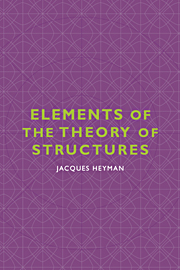Book contents
- Frontmatter
- Contents
- Preface
- 1 The theory of structures
- 2 Virtual work
- 3 Betti, Maxwell, Müller-Breslau, Melchers
- 4 Jettied construction
- 5 Clebsch, Macaulay, Wittrick, Lowe
- 6 The elastica
- 7 Mechanisms of collapse
- 8 The absolute minimum-weight design of frames
- 9 Inverse design of grillages
- 10 The relation between incremental and static plastic collapse
- 11 The bending of a beam of trapezoidal cross-section
- 12 The simple plastic bending of beams
- 13 Leaning walls; domes and fan vaults; the error function ∫e−t2dt
- Bibliography
- Name index
- Subject index
8 - The absolute minimum-weight design of frames
Published online by Cambridge University Press: 18 December 2009
- Frontmatter
- Contents
- Preface
- 1 The theory of structures
- 2 Virtual work
- 3 Betti, Maxwell, Müller-Breslau, Melchers
- 4 Jettied construction
- 5 Clebsch, Macaulay, Wittrick, Lowe
- 6 The elastica
- 7 Mechanisms of collapse
- 8 The absolute minimum-weight design of frames
- 9 Inverse design of grillages
- 10 The relation between incremental and static plastic collapse
- 11 The bending of a beam of trapezoidal cross-section
- 12 The simple plastic bending of beams
- 13 Leaning walls; domes and fan vaults; the error function ∫e−t2dt
- Bibliography
- Name index
- Subject index
Summary
The word ‘frame’ (or ‘beam’) implies, as usual, that the primary structural action is that of bending. Secondary actions, such as those of shear and of axial load, may have to be taken into account in design – certainly their effects must be checked. However, the first task of a designer is to establish a distribution of bending moments for the structure. Thereafter, calculations may proceed in one of two basic ways. If a plastic design is being made, then each member will be designed so that its full plastic moment just exceeds, at each critical section, the value of the bending moment established by the designer for that section. If an elastic approach is used, then the stresses at each section must be kept within certain specified limiting values.
The initial bending-moment distribution established by the designer is, of course, not unique; it is one of infinitely many that can be found for a hyperstatic structure. However, as has been seen in chapter 1, both the elastic and the plastic approach outlined above are, by the plastic theorems, safe. The plastic design is, in general, direct, whereas the elastic design is iterative, since the bending-moment distribution is affected by the elastic properties of the members, and these are not known a priori.
Prismatic members are commonly used in steelwork design, since it is inconvenient, except for heavy fabricated construction, to vary the cross-section of a member within its length.
- Type
- Chapter
- Information
- Elements of the Theory of Structures , pp. 73 - 80Publisher: Cambridge University PressPrint publication year: 1996



